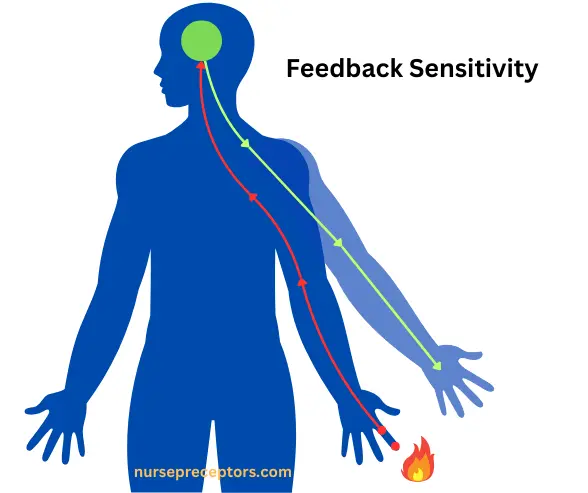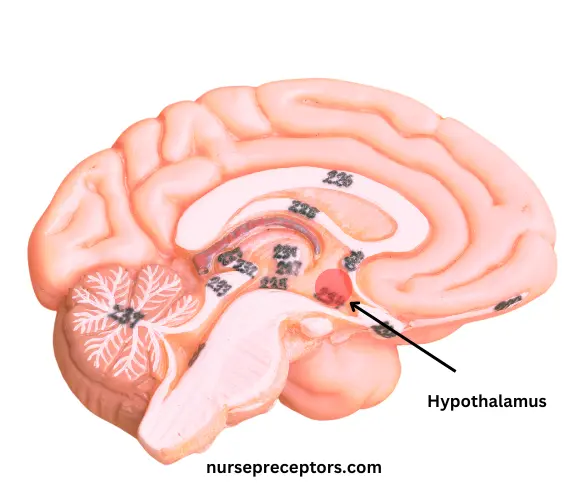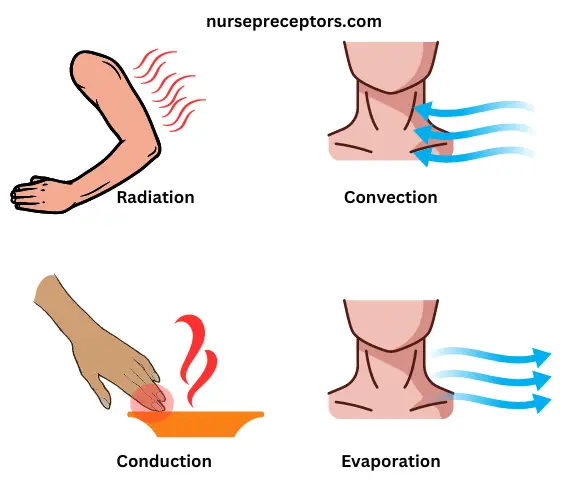What is the Human Thermoregulation?
Human thermoregulation is a vital biological process that helps the human body maintain its internal temperature within a narrow and optimal range, regardless of the external temperature. This process is crucial for human survival because numerous physiological processes rely on a stable internal environment.
The process of human thermoregulation involves multiple systems working together, such as temperature sensors located throughout the body, regulation in the brain’s hypothalamus, and various physiological and behavioral responses to temperature changes.
Peripheral and central temperature sensors continuously monitor and send vital information about the body’s internal and external temperature to the brain, which is crucial in understanding thermoregulation mechanisms.
This feedback loop enables the body to initiate appropriate responses to either produce or dissipate heat, thereby ensuring thermal equilibrium.
The process of maintaining a balanced internal temperature is not just a matter of comfort but a necessity for optimal physiological functioning and survival. Enzymatic reactions, metabolic processes, and overall cellular function are highly temperature-sensitive.
Without effective thermoregulation, the human body would be vulnerable to the detrimental effects of both hypothermia and hyperthermia, conditions that can impair organ function and potentially lead to fatal outcomes.
Principles of Human Thermoregulation
1. Homeostasis
Homeostasis is the body’s ability to maintain a stable internal environment for survival and proper functioning.
The human body operates best at an internal temperature of around 37 degrees Celsius, which it continuously strives to maintain. Any deviations from this optimal temperature trigger a series of responses intended to restore balance, demonstrating the body’s impressive ability to adapt.
The journey of maintaining this delicate balance begins with the detection of temperature changes, a task managed by specialized neurons scattered throughout the body.
2. Negative Feedback Loops
The body has a mechanism called a negative feedback loop that plays a crucial role in regulating its temperature. This mechanism operates on a simple principle: detect a change and implement actions to counteract that change, thereby restoring the body to its original temperature.
When the body detects that its temperature has deviated from the desired set point, negative feedback loops come into play, orchestrating a series of adjustments aimed at returning the body to its preferred temperature.
This system ensures that any deviation from the norm is met with an equal and opposite reaction, which involves a series of molecular and physiological processes that highlight the body’s resilience.
3. Integration of Signals
The regulation of body temperature is a complex process that involves several signals working together in harmony. The nervous system’s sensory neurons constantly monitor the internal and external thermal environment of the body.
The information gathered from these sensors is sent to the brain, which serves as the central control unit for human thermoregulation.
Here, in the hypothalamus, the collected data is analyzed, and decisions are made regarding the appropriate course of action.
This integration of signals ensures that the body’s response to temperature changes is both precise and coordinated a testament to the sophistication of human biology.
4. Effector Mechanisms
Effector mechanisms are the body’s tools for maintaining thermal balance, helping to maintain thermal homeostasis.
These mechanisms can be broadly categorized into two groups: those that generate heat and others that dissipate the heat.
When the temperature drops, the body can increase heat production through shivering and metabolic processes. Conversely, in the face of rising temperatures, mechanisms such as sweating and vasodilation help to expel excess heat.
These responses demonstrate how the body adapts to thermal challenges and uses a variety of strategies to maintain its internal environment.
5. Feedback Sensitivity
The sensitivity of the feedback system plays a crucial role in the efficacy of human thermoregulation. It determines not only the speed of the response but also its magnitude, ensuring that the body’s reactions are both timely and proportionate.
A highly sensitive feedback system can detect minute changes in temperature, triggering immediate and appropriate responses.
Conversely, a system with diminished sensitivity may fail to respond adequately to thermal stress, jeopardizing the body’s ability to maintain homeostasis.

6. Behavioral Responses
Beyond physiological adaptations, humans exhibit a range of behavioral responses to temperature changes. This provides further evidence of the complex nature of human thermoregulation.
These responses, which include seeking shade, altering clothing layers, and adjusting ambient temperatures, represent the interplay between biology and behavior in the pursuit of thermal comfort.
Such actions are guided by the principles of thermoregulation, rooted in the body’s instinctual drive to seek environments that support its homeostatic needs.
7. Adaptive Changes
Adaptation is a hallmark of life, and human thermoregulation is no exception. Humans have demonstrated remarkable adaptability to a wide range of environmental temperatures, a testament to the plasticity of the thermoregulatory system.
From the heat-acclimatized residents of the world’s deserts to the cold-adapted inhabitants of polar regions, the human body can undergo profound changes to optimize its thermoregulatory responses.
These adaptations, which include alterations in metabolic rate, insulation, and sweating capacity, underscore the dynamic nature of human thermoregulation, reflecting the body’s ability to tailor its responses to the demands of the environment.
8. Hormonal Regulation
The endocrine system plays a pivotal role in human thermoregulation, with several hormones influencing the body’s thermal responses.
Thyroid hormones, for instance, regulate metabolic rate and thus heat production, while cortisol and adrenaline can alter blood flow and metabolic processes in response to stress, including thermal stress.
This hormonal orchestration adds another layer of complexity to human thermoregulation, integrating metabolic and thermal homeostasis in a dance of endocrine regulation.
It highlights the interconnectedness of bodily systems, where thermal balance is intertwined with metabolic health, stress responses, and overall well-being.
Mechanisms of the Human Thermoregulation
1. Temperature Sensors
Temperature sensors, or thermoreceptors, are specialized nerve cells that play a critical role in the human body’s ability to detect changes in both external and internal temperatures.
These sensors are strategically located in the skin, the body’s largest organ, to monitor external temperature changes, as well as in the core, particularly in organs like the brain, to sense internal temperature fluctuations.
The information gathered by these sensors is continuously relayed to the hypothalamus, the central control point for thermoregulation.
- Peripheral Temperature Receptors: These are located throughout the body, particularly in the skin, and detect changes in external temperature.
- Internal Temperature Sensors: Receptors in the spinal cord and brain monitor core body temperature.
The thermoreceptors in the skin can be classified into two main types: those sensitive to cold and those sensitive to warmth.
When a deviation from the optimal temperature range is detected, these sensors trigger a signal that is transmitted through the nervous system to the hypothalamus.
This signaling is not just a simple transmission of data; it involves a complex network of neural pathways that ensure the body’s response is both swift and appropriate to the nature of the thermal challenge it faces.
2. Hypothalamic Regulation
The hypothalamus, a small but crucial component of the brain, serves as the command center for thermoregulation in the human body.
It receives and processes information from the temperature sensors, integrating various signals to make informed decisions about the necessary adjustments to body temperature.
This regulatory hub possesses the remarkable ability to compare the current body temperature with the ideal or set-point temperature, initiating responses to align the actual temperature with this set point.
- Anterior Hypothalamus: Responsible for heat dissipation mechanisms.
- Posterior Hypothalamus: Involved in heat conservation mechanisms.
- Integration: The hypothalamus integrates signals from temperature receptors and initiates responses to maintain temperature homeostasis.

This brain region utilizes a variety of effectors, such as the autonomic nervous system, the endocrine system, and behavioral response mechanisms, to maintain thermal balance.
Through its intricate network and multifaceted strategies, the hypothalamus ensures that the human body can adapt to and thrive in a wide range of thermal environments.
3. Heat Production (Thermogenesis)
Thermogenesis refers to the process through which the human body generates heat, a vital function for maintaining the core internal temperature within the optimal range.
There are several mechanisms through which thermogenesis occurs, each playing a role in different contexts or conditions.
- Basal Metabolic Processes: One primary method is through basal metabolic processes, where heat is produced as a byproduct of basic metabolic functions necessary for life, such as the breakdown of nutrients and cellular activities.
- Muscular Activity: Beyond basal metabolism, the body can increase heat production through muscular activity, such as shivering. Shivering thermogenesis involves rapid, involuntary muscle contractions, which significantly enhance heat production. This response is particularly notable when the body is exposed to cold environments, acting as a defense mechanism to prevent hypothermia.
- Brown Adipose Tissue (BAT): Another form of thermogenesis is non-shivering thermogenesis, which occurs mainly in brown adipose tissue (BAT). BAT is specialized in heat production and is more prevalent in infants, playing a crucial role in their ability to maintain body temperature.
- Diet: Diet-induced thermogenesis is another mechanism through which heat production is facilitated. Following the intake of food, the body’s metabolic rate temporarily increases as it digests and processes the nutrients, generating additional heat in the process.
4. Heat Loss
To maintain thermal equilibrium, the human body employs several mechanisms to dissipate excess heat, ensuring that the internal temperature remains within the optimal range.
- Radiation: One primary method of heat loss is through radiation, where heat is emitted from the body’s surface to the cooler surrounding environment. This process does not require direct contact with the cooler environment, making it a significant mode of heat dissipation under normal conditions.
- Conduction: Conduction is another mechanism through which heat loss occurs, involving the direct transfer of heat from the body to another surface that it is in contact with, such as cool water or a cold floor. While conduction can be an efficient way to reduce body temperature, its effectiveness depends on the temperature gradient between the body and the contacting surface, as well as the thermal conductivity of the materials involved.
- Convection: Convection enhances heat loss through the movement of air or water around the body. As the air or water that is in direct contact with the skin warms up, it moves away, replaced by cooler air or water, thus facilitating the transfer of heat from the body. This mechanism is amplified during physical activities, such as swimming or running, where the movement increases the flow of air or water across the body’s surface.
- Evaporation: Evaporation of sweat from the skin surface represents another vital mechanism of heat loss. When the body’s temperature rises, the sweat glands produce sweat, which then evaporates into the surrounding air, removing heat from the body. This process of evaporative cooling can be particularly effective in hot, dry environments, where the evaporation rate is high. However, its efficiency is diminished in humid conditions, where the air is already saturated with moisture, limiting the rate of evaporation.

5. Peripheral Vasoconstriction and Vasodilation
Peripheral vasoconstriction and vasodilation are critical processes in the body’s effort to regulate temperature.
- Vasoconstriction: Vasoconstriction refers to the narrowing of blood vessels near the skin surface, a response primarily triggered by exposure to cold temperatures. By constricting these vessels, the body reduces blood flow to the skin, minimizing heat loss and conserving warmth. This reaction is an essential component of the body’s defense against hypothermia, ensuring that the core organs remain adequately warm even in cold environments.
- Vasodilation: Conversely, vasodilation, the widening of peripheral blood vessels, occurs in response to increased body temperature, such as during physical exertion or exposure to hot conditions. This process facilitates greater blood flow to the skin, enhancing heat dissipation through mechanisms like radiation and convection. As blood, warmed by the body’s internal heat, reaches the skin’s surface, the heat is transferred to the environment, aiding in cooling the body down.
6. Behavioral Responses
In addition to physiological mechanisms, humans also rely on behavioral responses to regulate their body temperature. These responses are voluntary actions taken to increase comfort and ensure thermal equilibrium.
For instance, when feeling cold, individuals may put on additional layers of clothing, seek warmer environments, or increase physical activity to generate heat.
Conversely, in hot conditions, people might remove layers of clothing, seek shade or air-conditioned spaces, or reduce physical exertion to avoid overheating.
Moreover, the preference for certain foods and drinks as a response to ambient temperature reflects another dimension of behavioral human thermoregulation.
For example, the consumption of warm beverages and high-calorie foods in colder climates can contribute to increased heat production, while cold drinks and light meals are preferred in warm environments to minimize metabolic heat production.
7. Adaptive Changes
Over time, humans have developed adaptive changes to better cope with different thermal environments. These adaptations can be physiological, such as acclimatization to high altitudes or extreme temperatures, or cultural, involving changes in lifestyle, clothing, and shelter.
- Physiological Adaptations: Physiological adaptations may include increased sweat production in hot climates, allowing for more effective evaporative cooling, or enhanced metabolic heat production in cold climates, improving the body’s ability to generate warmth.
- Cultural Adaptations: Cultural adaptations, on the other hand, manifest in the development of clothing and architecture that protect against environmental extremes.
For example, lightweight, breathable fabrics are used in hot climates to facilitate heat loss, while insulating materials are favored in cold climates to conserve heat.
Similarly, the design of buildings and settlements reflects an understanding of environmental conditions, with features that enhance ventilation in hot areas or insulation in cold regions.
8. Hormonal Regulation
Hormonal regulation plays a significant role in the body’s thermoregulatory processes. Hormones, chemical messengers produced by the endocrine system, influence various aspects of human thermoregulation, including metabolism, heart rate, and vasomotor responses.
For example, thyroid hormones are known to affect metabolic rate, with increased levels leading to higher heat production, while adrenal hormones can influence vascular responses and sweat production.
The release of stress hormones, such as cortisol and adrenaline, can alter metabolic rates and cardiovascular function, impacting the body’s ability to produce or dissipate heat.
Additionally, hormones like insulin can affect thermoregulation indirectly by influencing metabolic processes and energy utilization.
Conclusion
Mastering comfort through an understanding of the mechanisms and principles of human thermoregulation requires an integrated approach, considering the physiological, behavioral, and adaptive strategies employed to maintain thermal equilibrium.
As we continue to explore and understand the intricacies of the human thermoregulation, we can develop more effective ways to adapt to our thermal environment, optimizing comfort and health in the face of climatic challenges.
Whether through advancements in clothing technology, architectural design, or medical interventions, the pursuit of better thermal comfort is a testament to the human capacity to innovate and adapt in response to the natural world.
In embracing the principles of thermoregulation, we open the door to a future where comfort and sustainability go hand in hand, where our living environments are in harmony with our biological requirements.
References:
- Holland, K. (2017, June 7). Thermoregulation | Definition and Patient Education. Healthline. https://www.healthline.com/health/thermoregulation#takeaway
- openanesthesia. (n.d.). Normal Thermoregulation. OpenAnesthesia. https://www.openanesthesia.org/keywords/normal-thermoregulation/
- Byjus. (2018, July 23). Thermoregulation. BYJUS; Byju’s. https://byjus.com/biology/thermoregulation/
- Thermoregulation. (n.d.). Unacademy. Retrieved May 4, 2024, from https://unacademy.com/content/csir-ugc/study-material/life-sciences/thermoregulation/
- Mota-Rojas, D., Titto, C. G., Orihuela, A., Martínez-Burnes, J., Gómez-Prado, J., Torres-Bernal, F., Flores-Padilla, K., Carvajal-de la Fuente, V., & Wang, D. (2021). Physiological and Behavioral Mechanisms of Thermoregulation in Mammals. Animals, 11(6), 1733. https://doi.org/10.3390/ani11061733
- Berman, A., Snyder, S., & Frandsen, G. (2016). Kozier & Erb’s Fundamentals of Nursing: Concepts, Practice, and Process (10th ed.). Pearson.
- Delaune, S. C., & Ladner, P. K. (2002). Fundamentals of nursing : standards & practice. Delmar Thomson Learning.
- Patricia Ann Potter, Anne Griffin Perry, Stockert, P. A., & Hall, A. (2018). Essentials for nursing practice. Elsevier.